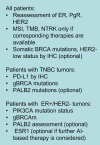Breast cancer: an up-to-date review and future perspectives
- PMID: 36074908
- PMCID: PMC9558690
- DOI: 10.1002/cac2.12358
Breast cancer: an up-to-date review and future perspectives
Abstract
Breast cancer is the most common cancer worldwide. The occurrence of breast cancer is associated with many risk factors, including genetic and hereditary predisposition. Breast cancers are highly heterogeneous. Treatment strategies for breast cancer vary by molecular features, including activation of human epidermal growth factor receptor 2 (HER2), hormonal receptors (estrogen receptor [ER] and progesterone receptor [PR]), gene mutations (e.g., mutations of breast cancer 1/2 [BRCA1/2] and phosphatidylinositol-4,5-bisphosphate 3-kinase catalytic subunit alpha [PIK3CA]) and markers of the immune microenvironment (e.g., tumor-infiltrating lymphocyte [TIL] and programmed death-ligand 1 [PD-L1]). Early-stage breast cancer is considered curable, for which local-regional therapies (surgery and radiotherapy) are the cornerstone, with systemic therapy given before or after surgery when necessary. Preoperative or neoadjuvant therapy, including targeted drugs or immune checkpoint inhibitors, has become the standard of care for most early-stage HER2-positive and triple-negative breast cancer, followed by risk-adapted post-surgical strategies. For ER-positive early breast cancer, endocrine therapy for 5-10 years is essential. Advanced breast cancer with distant metastases is currently considered incurable. Systemic therapies in this setting include endocrine therapy with targeted agents, such as CDK4/6 inhibitors and phosphoinositide 3-kinase (PI3K) inhibitors for hormone receptor-positive disease, anti-HER2 targeted therapy for HER2-positive disease, poly(ADP-ribose) polymerase inhibitors for BRCA1/2 mutation carriers and immunotherapy currently for part of triple-negative disease. Innovation technologies of precision medicine may guide individualized treatment escalation or de-escalation in the future. In this review, we summarized the latest scientific information and discussed the future perspectives on breast cancer.
© 2022 The Authors. Cancer Communications published by John Wiley & Sons Australia, Ltd. on behalf of Sun Yat-sen University Cancer Center.
Conflict of interest statement
The authors declare that they have no competing interests.
Figures


References
-
- Sung H, Ferlay J, Siegel RL, Laversanne M, Soerjomataram I, Jemal A, et al. Global Cancer Statistics 2020: GLOBOCAN Estimates of Incidence and Mortality Worldwide for 36 Cancers in 185 Countries. CA Cancer J Clin. 2021;71(3):209–49. - PubMed
-
- Li T, Mello‐Thoms C, Brennan PC. Descriptive epidemiology of breast cancer in China: incidence, mortality, survival and prevalence. Breast Cancer Res Treat. 2016;159(3):395–406. - PubMed
Publication types
MeSH terms
Substances
LinkOut - more resources
Full Text Sources
Research Materials
Miscellaneous

